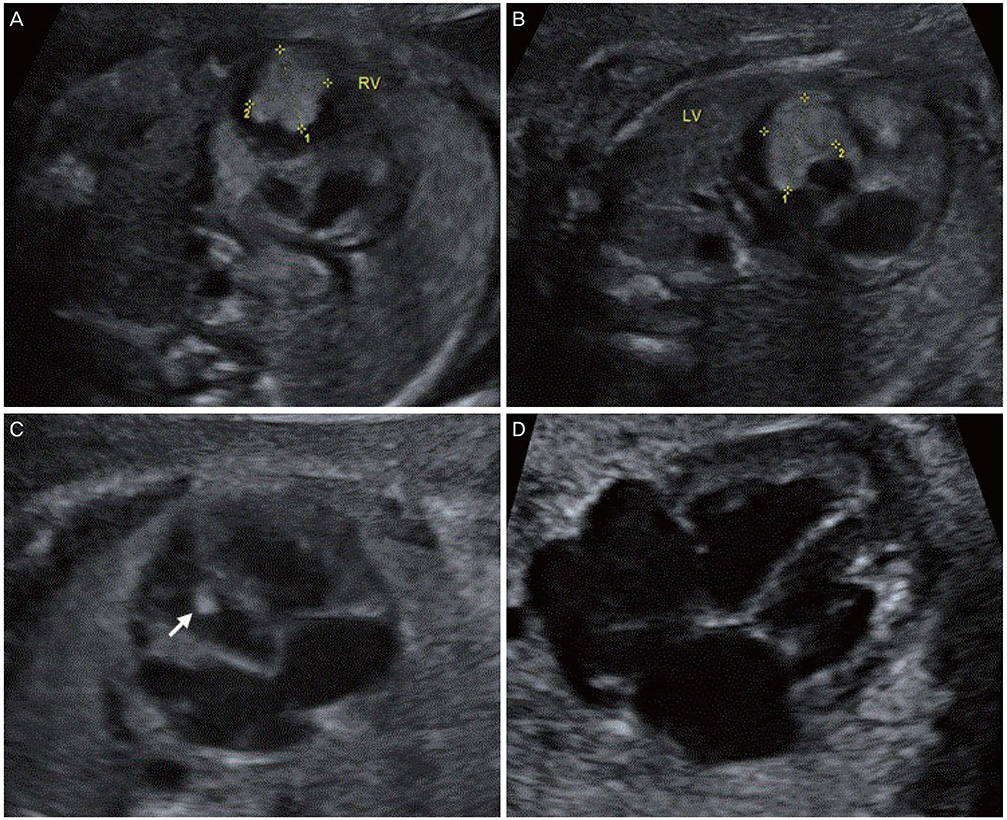Obstet Gynecol Sci.
2019 Jul;62(4):280-284. 10.5468/ogs.2019.62.4.280.
Sirolimus therapy for fetal cardiac rhabdomyoma in a pregnant woman with tuberous sclerosis
- Affiliations
-
- 1Department of Obstetrics and Gynecology, Samsung Medical Center, Sungkyunkwan University School of Medicine, Seoul, Korea. crroh@skku.edu
- KMID: 2451658
- DOI: http://doi.org/10.5468/ogs.2019.62.4.280
Abstract
- Rhabdomyoma is the most common fetal cardiac tumor, and its development is related to tuberous sclerosis. Fetal cardiac rhabdomyomas often spontaneously regress in utero or after birth, but large tumors can cause hemodynamic obstruction. Sirolimus, a mammalian target of rapamycin (mTOR) inhibitor, has been used as an immunosuppressant after organ transplantation. The mTOR inhibitors are well-known to have anti-tumor activity, and they have been used for the treatment of patients with tuberous sclerosis. In the current case, fetal cardiac rhabdomyoma was completely resolved in utero during oral sirolimus treatment in the mother with tuberous sclerosis. This case shows that oral sirolimus therapy in pregnancy may be a treatment for multiple or large fetal cardiac rhabdomyomas.
Keyword
MeSH Terms
Figure
Reference
-
1. Barnes BT, Procaccini D, Crino J, Blakemore K, Sekar P, Sagaser KG, et al. Maternal sirolimus therapy for fetal cardiac rhabdomyomas. N Engl J Med. 2018; 378:1844–1845.
Article2. Fesslova V, Villa L, Rizzuti T, Mastrangelo M, Mosca F. Natural history and long-term outcome of cardiac rhabdomyomas detected prenatally. Prenat Diagn. 2004; 24:241–248.
Article3. Breathnach C, Pears J, Franklin O, Webb D, McMahon CJ. Rapid regression of left ventricular outflow tract rhabdomyoma after sirolimus therapy. Pediatrics. 2014; 134:e1199–202.
Article4. Ninic S, Kalaba M, Jovicic B, Vukomanovic V, Prijic S, Vucetic B, et al. Successful use of sirolimus for refractory atrial ectopic tachycardia in a child with cardiac rhabdomyoma. Ann Noninvasive Electrocardiol. 2017; 22:e12435.
Article5. Demir HA, Ekici F, Yazal Erdem A, Emir S, Tunç B. Everolimus: a challenging drug in the treatment of multifocal inoperable cardiac rhabdomyoma. Pediatrics. 2012; 130:e243–7.
Article6. Sasongko TH, Ismail NF, Zabidi-Hussin Z. Rapamycin and rapalogs for tuberous sclerosis complex. Cochrane Database Syst Rev. 2016; 7:CD011272.
Article7. Bader RS, Chitayat D, Kelly E, Ryan G, Smallhorn JF, Toi A, et al. Fetal rhabdomyoma: prenatal diagnosis, clinical outcome, and incidence of associated tuberous sclerosis complex. J Pediatr. 2003; 143:620–624.
Article8. Rapamune (sirolimus) oral solution and tablets. Philadelphia (PA): Wyeth Pharmaceuticals, Inc;2012.9. Briggs GG, Freeman RK, Towers CV, Forinash AB. Drugs in pregnancy and lactation: a reference guide to fetal and neonatal risk. 10th ed. Philadelphia (PA): Wolters Kluwer;2015.10. Framarino-dei-Malatesta M, Derme M, Manzia TM, Iaria G, De Luca L, Fazzolari L, et al. Impact of mTOR-I on fertility and pregnancy: state of the art and review of the literature. Expert Rev Clin Immunol. 2013; 9:781–789.11. Costanzo MR, Dipchand A, Starling R, Anderson A, Chan M, Desai S, et al. The International Society of Heart and Lung Transplantation Guidelines for the care of heart transplant recipients. J Heart Lung Transplant. 2010; 29:914–956.
- Full Text Links
- Actions
-
Cited
- CITED
-
- Close
- Share
- Similar articles
-
- A Case of Fetal Hydrops combined with Intracardiac Rhabdomyoma and Tuberous Sclerosis
- Fetal Ultrasonography for Prenatal Detection of Tuberous Sclerosis Associated with Cardiac Rhabdomyoma
- A Case of Fetal Cardiac Tumor Diagnosed by Ultrasonography
- A Case of Fetal Cardiac Rhabdomyoma with Tuberous Sclerosis
- A Case of Fetal Intracardiac Tumor Detected on Fetal Echocardiography



